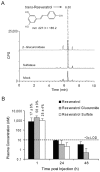Resveratrol given intraperitoneally does not inhibit the growth of high-risk t(4;11) acute lymphoblastic leukemia cells in a NOD/SCID mouse model
- PMID: 22200740
- PMCID: PMC3270126
- DOI: 10.3892/ijo.2011.1316
Resveratrol given intraperitoneally does not inhibit the growth of high-risk t(4;11) acute lymphoblastic leukemia cells in a NOD/SCID mouse model
Abstract
The efficacy of resveratrol as a preventive agent against the growth of t(4;11) acute lymphoblastic leukemia (ALL) was evaluated in NOD.CB17-Prkdcscid/J mice engrafted with the human t(4;11) ALL SEM cell line. SEM cells were injected into the tail vein and engraftment was monitored by flow cytometry. Once engraftment was observed, mice were injected intraperitoneally with resveratrol (10 mg/kg body weight) dissolved in dimethylsulfoxide (DMSO) or DMSO alone (control) every other day, or vincristine (0.5 mg/kg body weight) 3 times per week for 4 weeks (n=16 per group). Comparisons of the percent of human leukemia cells in blood and survival curves showed resveratrol did not inhibit progression of the disease. Liquid chromatography-tandem mass spectrometry analyses of mouse sera showed resveratrol was rapidly metabolized to glucuronidated and sulfated forms 1 h post-injection, with low to no resveratrol or metabolites observed in sera by 24-48 h. These data indicate that in contrast to findings in in vitro models, parenterally administered resveratrol does not have potential as a preventive agent against high risk t(4;11) ALL.
Figures





Similar articles
-
Dietary resveratrol does not delay engraftment, sensitize to vincristine or inhibit growth of high-risk acute lymphoblastic leukemia cells in NOD/SCID mice.Int J Oncol. 2012 Dec;41(6):2207-12. doi: 10.3892/ijo.2012.1650. Epub 2012 Oct 4. Int J Oncol. 2012. PMID: 23041950 Free PMC article.
-
Oral or parenteral administration of curcumin does not prevent the growth of high-risk t(4;11) acute lymphoblastic leukemia cells engrafted into a NOD/SCID mouse model.Int J Oncol. 2013 Feb;42(2):741-8. doi: 10.3892/ijo.2012.1734. Epub 2012 Dec 12. Int J Oncol. 2013. PMID: 23232667 Free PMC article.
-
Novel in vivo model of inducible multi-drug resistance in acute lymphoblastic leukemia with chromosomal translocation t(4;11).Cancer Lett. 2010 Oct 1;296(1):49-54. doi: 10.1016/j.canlet.2010.03.017. Epub 2010 Apr 9. Cancer Lett. 2010. PMID: 20381955 Free PMC article.
-
Molecular mechanism of the chemopreventive effect of resveratrol.Mutat Res. 2003 Feb-Mar;523-524:145-50. doi: 10.1016/s0027-5107(02)00330-5. Mutat Res. 2003. PMID: 12628512 Review.
-
A reappraisal of the potential chemopreventive and chemotherapeutic properties of resveratrol.Carcinogenesis. 2001 Aug;22(8):1111-7. doi: 10.1093/carcin/22.8.1111. Carcinogenesis. 2001. PMID: 11470738 Review.
Cited by
-
Effect of resveratrol on behavioral performance of streptozotocin-induced diabetic mice in anxiety tests.Exp Anim. 2014;63(3):277-87. doi: 10.1538/expanim.63.277. Exp Anim. 2014. PMID: 25077757 Free PMC article.
-
Resveratrol and clinical trials: the crossroad from in vitro studies to human evidence.Curr Pharm Des. 2013;19(34):6064-93. doi: 10.2174/13816128113199990407. Curr Pharm Des. 2013. PMID: 23448440 Free PMC article. Review.
-
Targeting Cancer Via Resveratrol-Loaded Nanoparticles Administration: Focusing on In Vivo Evidence.AAPS J. 2019 Apr 23;21(4):57. doi: 10.1208/s12248-019-0325-y. AAPS J. 2019. PMID: 31016543 Review.
-
Dietary resveratrol does not delay engraftment, sensitize to vincristine or inhibit growth of high-risk acute lymphoblastic leukemia cells in NOD/SCID mice.Int J Oncol. 2012 Dec;41(6):2207-12. doi: 10.3892/ijo.2012.1650. Epub 2012 Oct 4. Int J Oncol. 2012. PMID: 23041950 Free PMC article.
-
Plausible anti-inflammatory mechanism of resveratrol and caffeic acid against chronic stress-induced insulin resistance in mice.Inflammopharmacology. 2016 Dec;24(6):347-361. doi: 10.1007/s10787-016-0287-y. Epub 2016 Oct 19. Inflammopharmacology. 2016. PMID: 27761692
References
-
- Aggarwal BB, Bhardwaj A, Aggarwal RS, Seeram NP, Shishodia S, Takada Y. Role of resveratrol in prevention and therapy of cancer: preclinical and clinical studies. Anticancer Res. 2004;24:2783–2840. - PubMed
-
- Jang M, Cai L, Udeani GO, Slowing KV, Thomas CF, Beecher CWW, Fong HHS, Farnsworth NR, Kinghorn AD, Mehta RG, Moon RC, Pezzuto JM. Cancer chemopreventive activity of resveratrol, a natural product derived from grapes. Science. 1997;275:218–220. - PubMed
-
- Banerjee S, Bueso-Ramos C, Aggarwal BB. Suppression of 7,12- dimethylbenz(a)anthracene-induced mammary carcinogenesis in rats by resveratrol: role of nuclear factor-κB, cyclooxygenase 2, and matrix metalloproteinase 9. Cancer Res. 2002;62:4945–4954. - PubMed
-
- Li ZG, Hong T, Shimada Y, Komoto I, Kawabe A, Ding Y, Kaganoi J, Hashimoto Y, Imamura M. Suppression of N-nitrosomethylbenzylamine (NMBA)-induced esophageal tumorigenesis in F344 rats by resveratrol. Carcinogenesis. 2002;23:1531–1536. - PubMed
-
- Lee EO, Lee HJ, Hwang HS, Ahn KS, Chae C, Kang KS, Lu J, Kim SH. Potent inhibition of Lewis lung cancer growth by heyneanol A from the roots of Vitis amurensis through apoptotic and anti-angiogenic activities. Carcinogenesis. 2006;27:2059–2069. - PubMed

